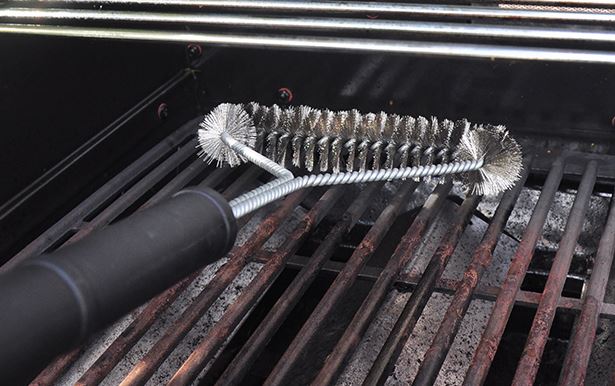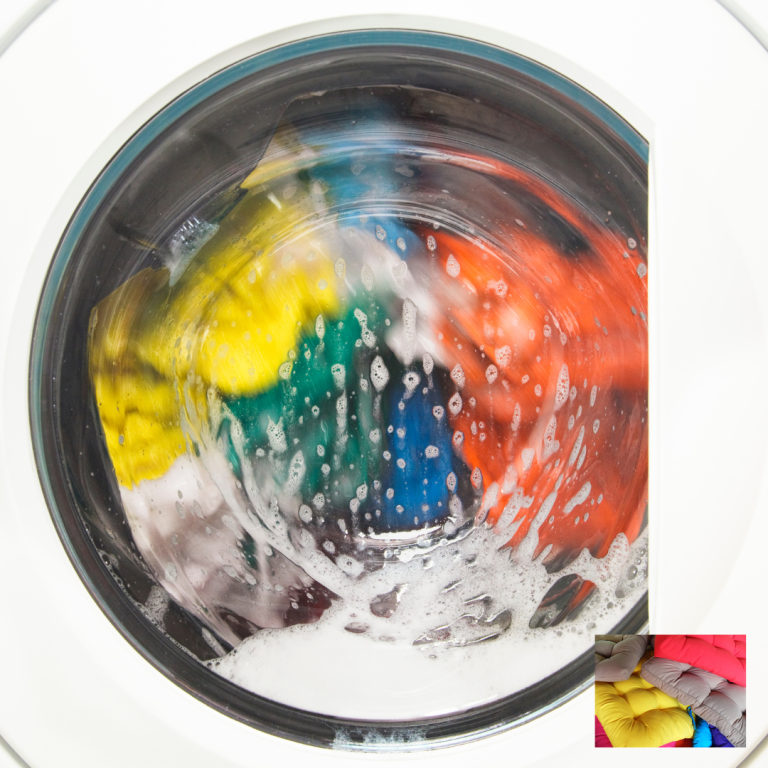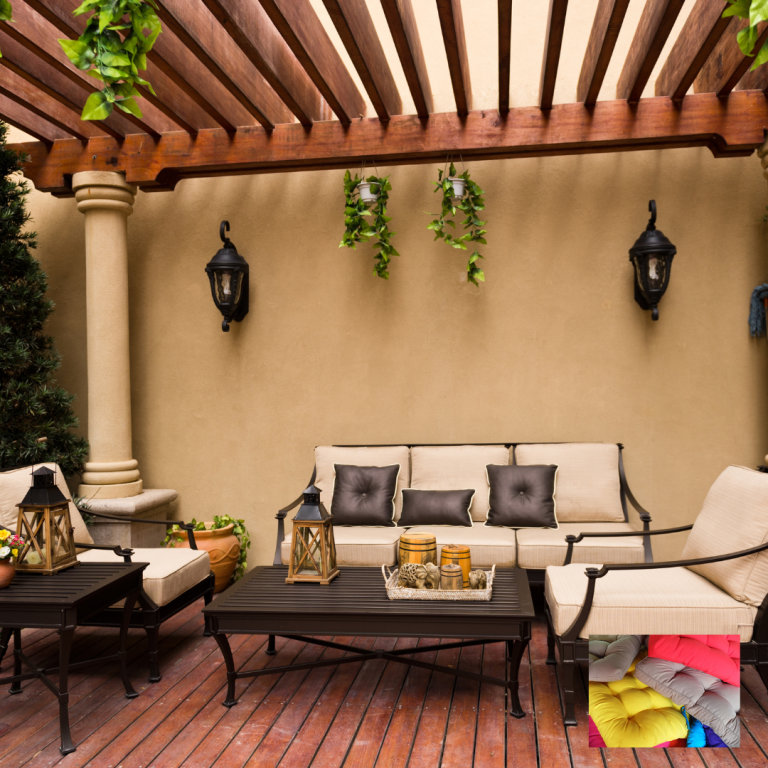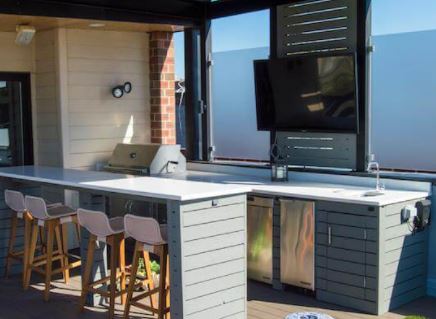Utility Meter Cover Ideas
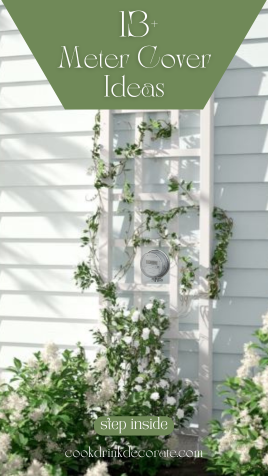
13 Utility Meter Cover Ideas to Enhance Curb Appeal and Conceal Eyesores
Utility meters are important but often stick out in ways that disrupt your home’s style. With the right meter cover ideas, you can help your gas and electrical meters blend smoothly into your home’s exterior and landscaping.
Nothing will dampen that perfect party vibe you’ve created in your backyard quite like a tangle of utility meters your guests have to pass by on their way to your event.
You’ll find that most solutions are easy to make yourself and can fit a variety of styles, like modern, farmhouse, or coastal. No matter what your home looks like, you can find meter cover ideas that keep meters accessible while making your outdoor space look even better.
Louvered Wood Panels Painted to Match the House
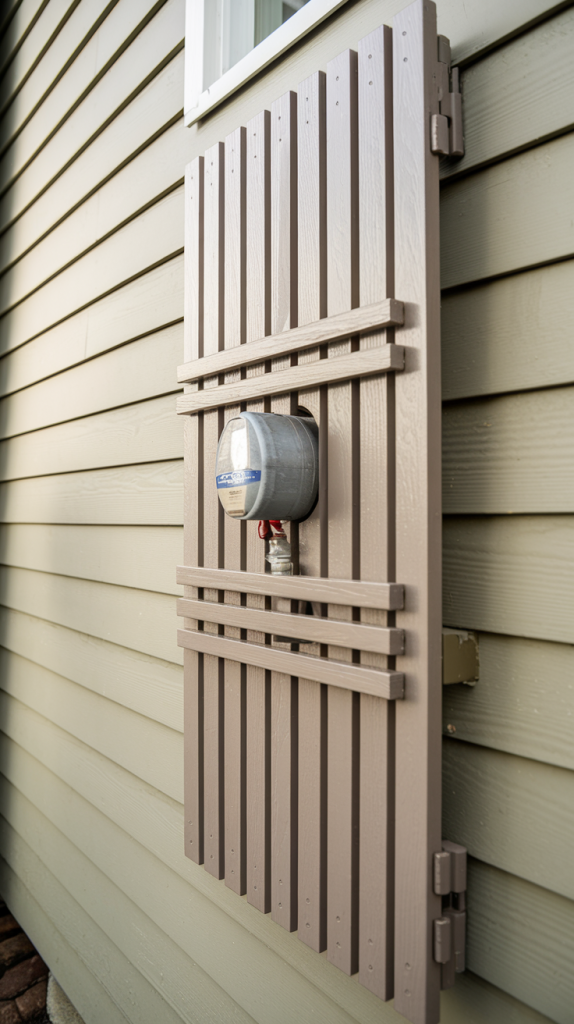
You can make a simple but stylish meter cover using louvered wood panels. Use either vertical or horizontal slats to let air move freely through the panel. This helps prevent heat build-up and makes sure your meter stays easy to read.
Paint the panels to match your home’s exterior color. When the paint matches your siding, the cover blends in and doesn’t stand out from the rest of your house. This gives a neat, uniform look.
To install, mount the panel on hinges or removable brackets. This keeps the cover easy to open when you need to check the meter or let the utility company access it.
Materials you need include basic lumber for the frame and slats, outdoor paint, hinges or brackets, and a drill or screwdriver. This project fits anyone with beginner woodworking skills.
The finished cover looks tidy and practical while allowing the meter to stay visible enough for checks and readings.
Decorative Shutter Screen
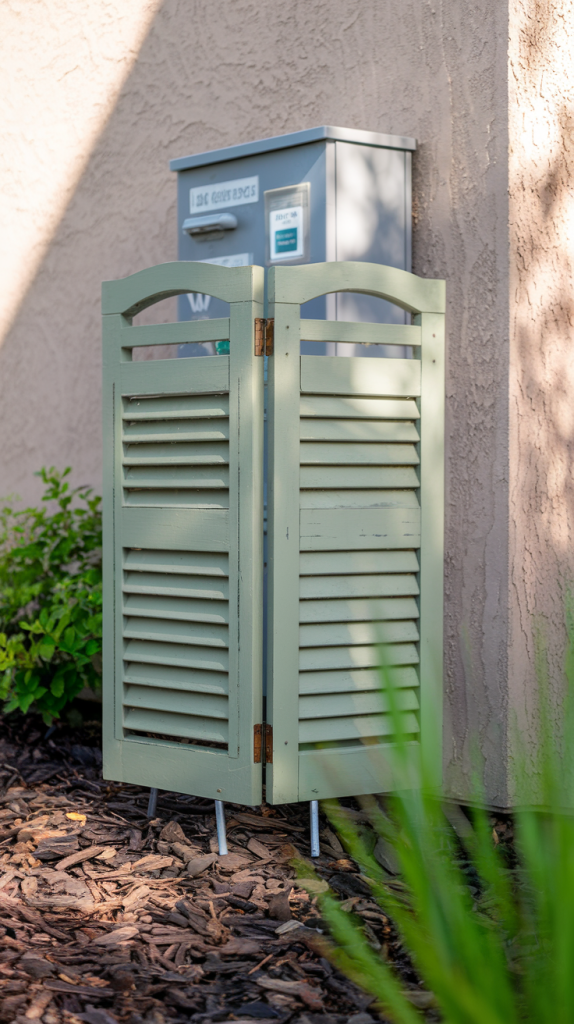
Using old window shutters is a simple way to hide a gas or electric meter. You can find salvaged shutters at thrift stores or salvage yards. Clean them well and repaint them in a color that matches or complements your home’s exterior, like a muted sage green or classic white.
Attach two shutters together with outdoor hinges to create a folding screen. Place small legs or stakes on the bottom for stability, then set the screen in front of the meter in a mulched garden bed. Make sure you leave space for easy access to the meter when needed.
Choose shutter colors that fit with your siding, trim, or garden accents for a coordinated look. For a touch of charm, add simple details like a hanging house number or tiny hooks for garden tools. This solution fits nicely with cottage or traditional styles, and won’t look out of place in most neighborhoods. The setup is easy to move for meter readings or repairs.
Small Vertical Garden or Trellis Planter

A vertical garden or trellis planter is an effective way to disguise a utility meter while still allowing access. Place a wooden trellis or a set of stacked planters in front of the meter, leaving a few inches of space for air flow and maintenance.
Choose climbing plants like clematis, sweet pea, or star jasmine that will grow well in your climate. Avoid thorny or invasive varieties to make future access to the meter easier and safer.
Place the trellis so it does not block the meter completely. Make sure you can move the planter or easily reach behind it when needed. Secure the trellis to the ground or wall if you live in a windy area.
Water your plants regularly, and trim back growth if it starts to cover the meter or its dials. Check plant roots occasionally to prevent them from damaging nearby wires or pipes. Use potting soil that drains well to avoid water pooling next to the meter.
Stone or Faux-Stone Utility Box
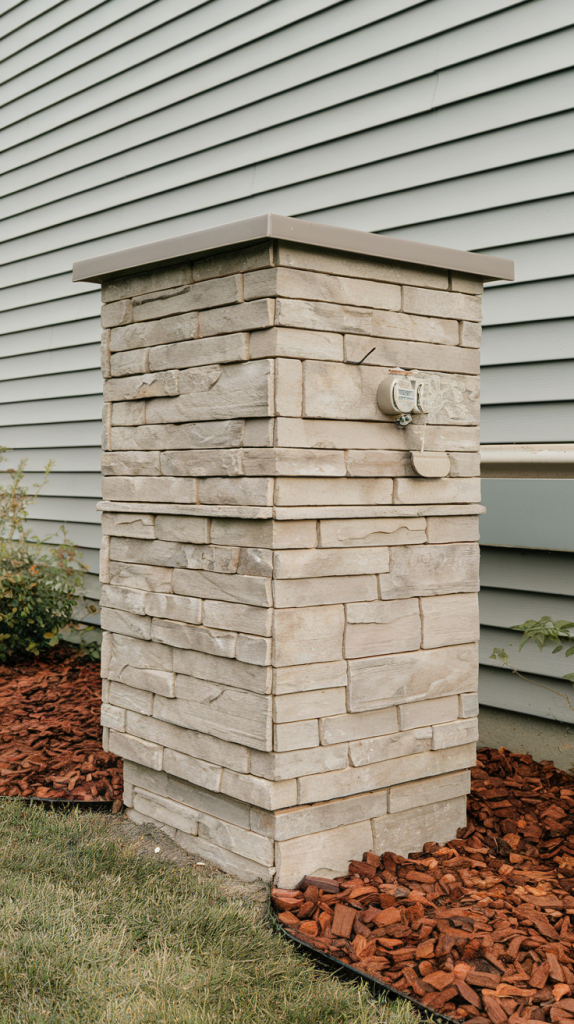
A stone or faux-stone meter cover gives your utility box a natural look that blends into your yard. You can find box-style covers made from real stone panels or lightweight faux stone. These covers are usually built as simple rectangles, big enough to fit over most ground-level meters.
Choosing a stone look that matches your home’s foundation or garden beds will help the cover blend in. Neutral earth tones like gray, beige, or tan work well with many siding types. This style also fits nicely next to rustic homes or houses with brick or stone details.
Most faux-stone covers are weather-resistant and easy to clean. Make sure the cover has vents or small gaps, so the meter stays cool and dry. Good designs include removable panels or lids for quick access by utility workers.
Surrounding your stone meter box with mulch or low plants helps it look even more natural. Place the cover level on the ground for a neat appearance. This is a simple way to hide your meter without much upkeep.
Slatted Fence Extension or Wraparound
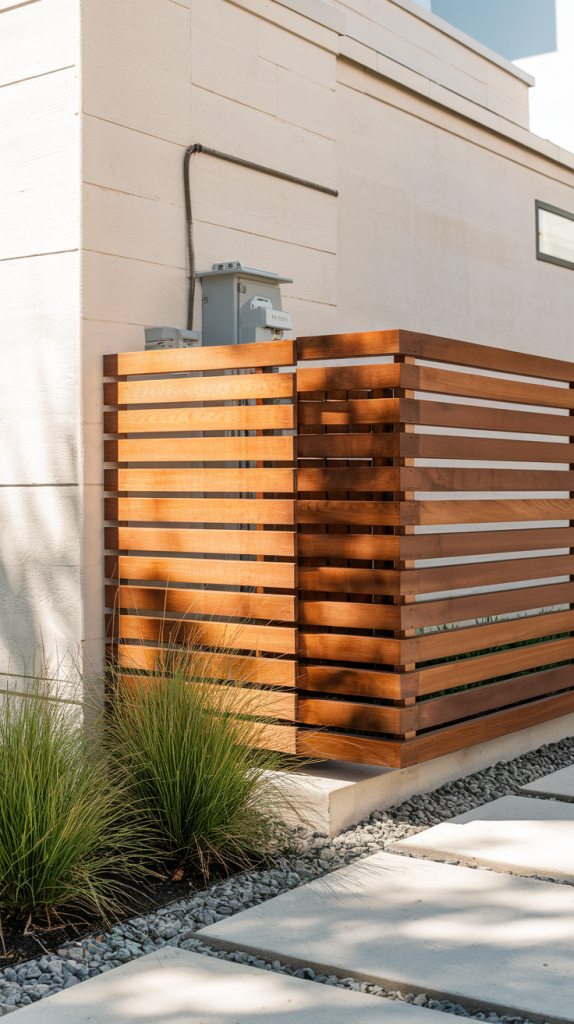
You can build a simple slatted fence extension to hide utility meters next to your home. Use horizontal wooden slats for a clean, modern look that matches most home exteriors. Choose a stain color like walnut or gray to blend with your siding and outdoor colors.
This wraparound design breaks up the boxy shape of the meter with sharp lines and neat shadows. A short horizontal fence is easy to build with basic wood and tools, even for beginners. The open slats allow good airflow and make sure meters can still be read.
With this style, you get a polished result while keeping access clear for utility workers. Place modern landscaping like gravel or grasses around the base for a finished appearance. The look is practical, stylish, and fits well in most neighborhoods.
Cabinet-Style Cover with Hinged Doors
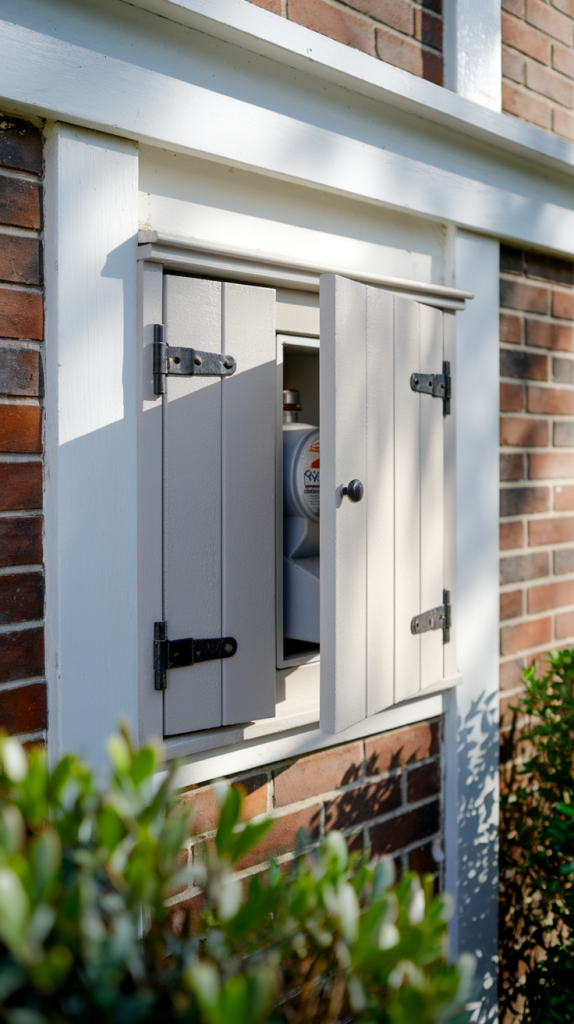
A cabinet-style cover with small hinged doors is a practical and attractive way to hide a utility meter. This design works well for meters mounted on exterior walls, such as brick, stucco, or siding.
You can build a box that fits over the meter, using painted wood to match your home’s trim or siding. Hinged doors allow quick access for meter readings or repairs. Using matte black hardware can add a subtle but stylish accent.
This cabinet approach fits in with modern, coastal, or farmhouse homes. The clean lines and simple finish blend in quietly without drawing attention. Some homeowners leave the doors slightly open or add small vents for airflow around the meter.
Mounting the cover so it sits flush with your wall makes it look built-in. If you keep the cabinet’s size just right, it won’t stick out too far or get in the way. This lets your utility area look neat while still being easy to use.
Recessed Niche with Flush Panel Door
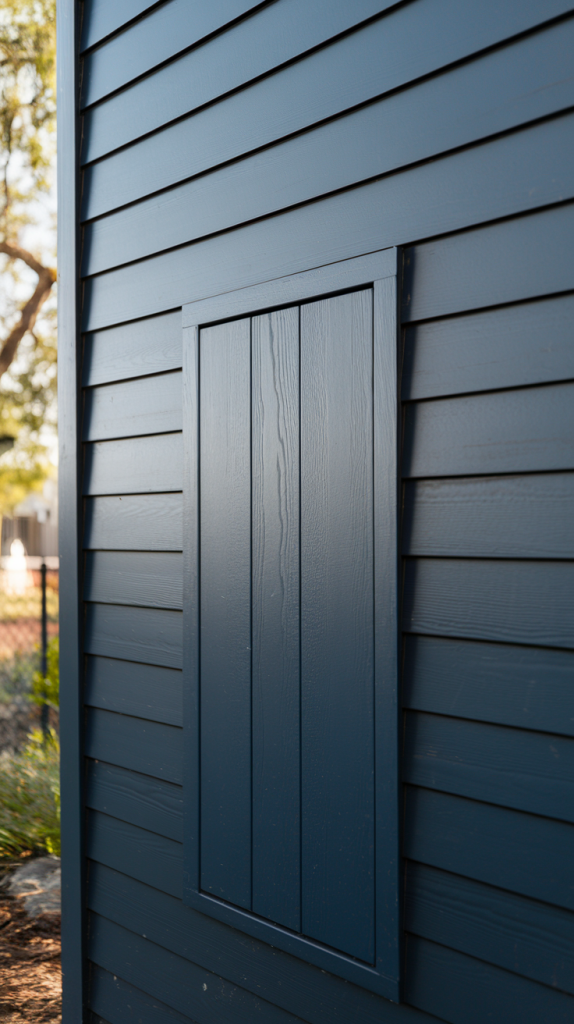
A recessed wall niche with a flush panel door keeps your utility meter hidden without adding extra bulk to your home’s exterior. The door fits precisely within the wall, staying level with the siding or surface. This makes the meter panel look almost invisible from a distance.
You can paint the flush door to perfectly match the surrounding exterior. This camouflages the panel, especially on homes with uniform siding like lap boards or stucco. The seams stay narrow and smooth, so the door blends into the wall.
This cover style works especially well for modern or minimalist houses. It keeps the lines of your exterior clean and simple. There are no obvious frames or handles disrupting the surface.
Access remains easy. The door opens when needed for meter readings or maintenance, then closes to continue the seamless look. It is a practical choice for anyone who wants a neat, uncluttered home appearance.
Outdoor Art Screen or Panel
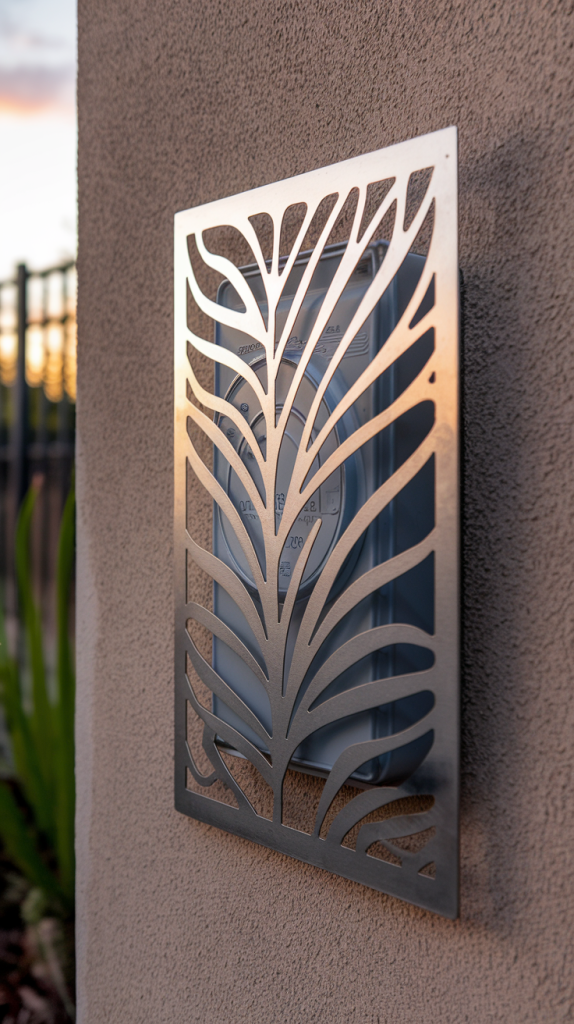
You can turn a plain utility meter into a feature by using a decorative outdoor screen or a laser-cut metal panel as a cover. These screens are designed for outdoor use, so they can handle rain and sun without getting damaged. Choose a pattern that fits your style, such as leaves, waves, or abstract shapes.
These panels come in many looks, including modern, tropical, and desert themes. Pick a color that matches your home or landscape for a unified look. Some are powder-coated to prevent rust, which keeps your screen looking fresh for longer.
Mount the panel a few inches away from the meter and the wall. This gives enough space for airflow and allows easy access for meter reads or maintenance. The screen softens the look of the meter without blocking it completely.
Installation is usually simple. Some panels attach to small posts anchored in the ground, while others can be fixed to a wall or fence. Adjust the height and angle for best coverage and style. This way, you keep your meter easy to access but much nicer to look at.
Bench or Storage Box Disguise
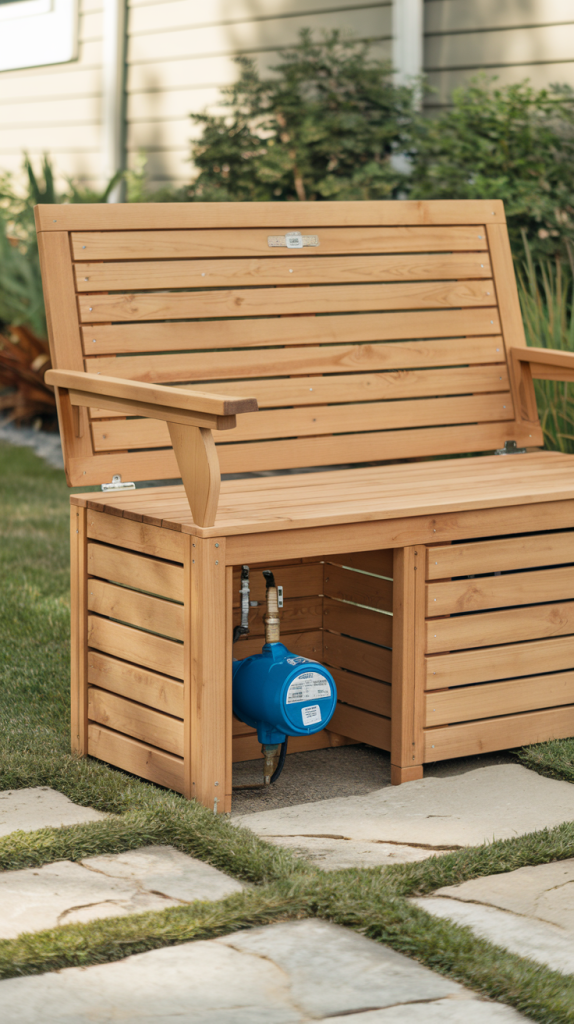
Hiding a utility meter behind a bench or storage box blends function and style in your yard. You can use a simple outdoor storage bench to shield a ground-level gas or water meter, especially near patios or back porches.
A bench with a hinged lid lets you access the meter when needed. Leave vents or gaps along the sides to keep air moving around the meter, which is important for proper operation. Choose weather-resistant materials like stained cedar to match your existing home trim or outdoor furniture.
This approach is effective for small entryways or narrow side yards where space is tight. It also adds extra storage for garden tools, shoes, or outdoor toys while hiding unsightly equipment.
Place the bench on grass or stepping stones, making sure the meter stays accessible for readings or maintenance. Keep the design in scale with your home, so it fits naturally along walkways or foundation walls.
Lattice Fence with Planter Box Base
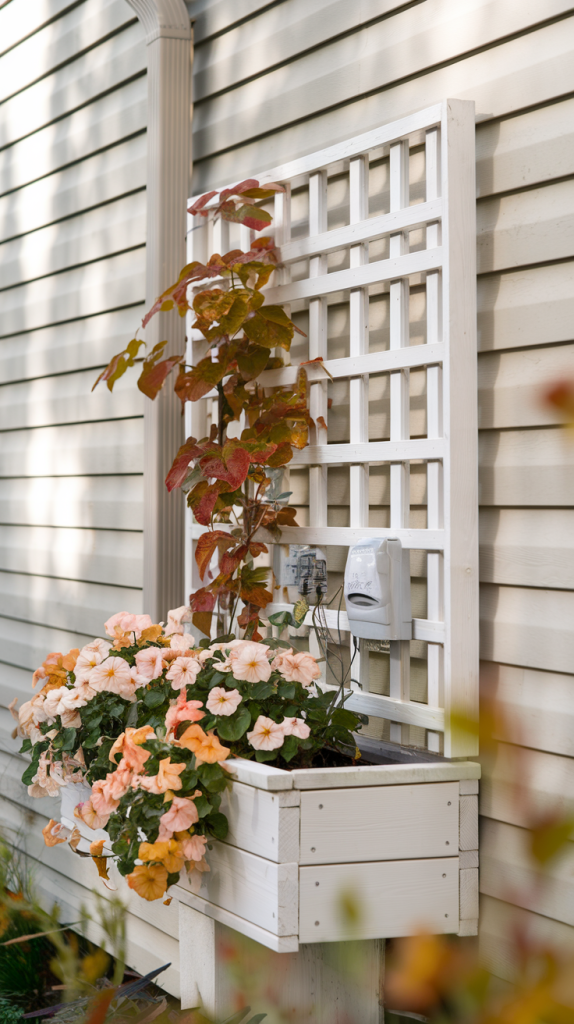
A lattice fence with a planter box at the base is a practical way to hide your utility meter. You can build a simple frame out of wood, attach lattice panels, and secure a rectangular planter box along the bottom.
The lattice screen gives enough coverage to keep the meter out of sight but still allows airflow. You can paint the lattice white to blend with most siding types, including vinyl or brick.
Fill the planter box with flowers or herbs in colors that match the season. As plants grow, they create more visual interest and help the screen blend into your yard.
Place the screen a few inches in front of the meter so you can still access it for readings or maintenance. Climbing plants can also use the lattice for support, adding another layer of natural coverage.
This setup is useful for keeping your outdoor space neat while adding a decorative element. You do not need advanced skills or tools—basic carpentry and gardening knowledge are enough.
Movable Art Panel on Wheels
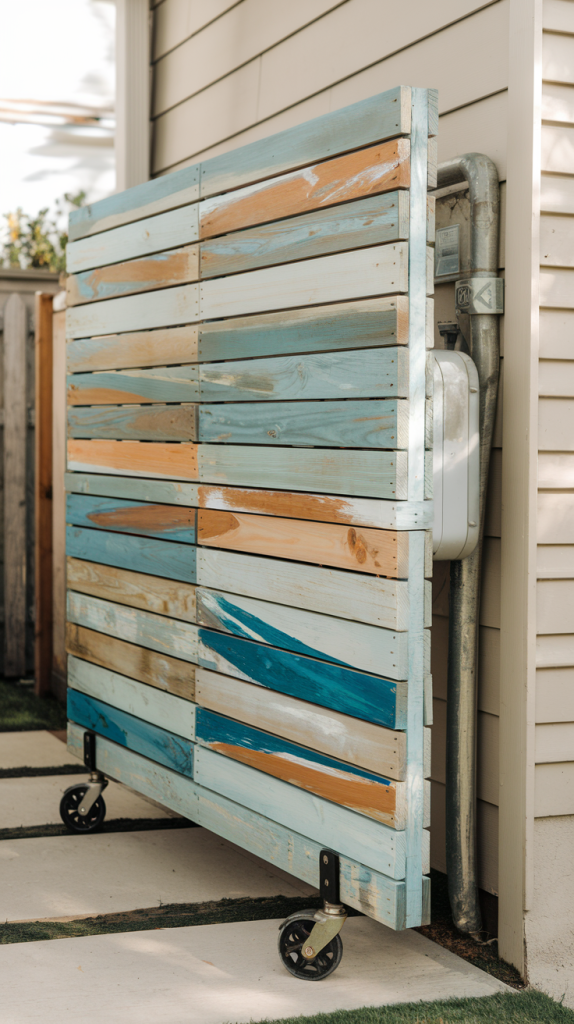
You can hide your utility meter with a wooden art screen built on castor wheels. This kind of cover lets you move the panel easily when the meter needs to be checked. By choosing lockable wheels, you can make sure the panel stays in place and doesn’t roll away in wind or when bumped.
Try using reclaimed wood slats for your panel. Paint them with simple patterns or abstract beachy colors to match your home’s exterior. Over time, the finish may weather a bit, but this adds character and helps the panel blend into outdoor spaces.
Position the panel on a side-yard walkway, making sure the meter sits just behind it. If slight gaps between the slats let the meter peek through, that’s normal and keeps it easy to find. Place the wheels on flat ground so the cover stands straight.
Set your panel at a slight angle from the walkway for a natural look. On a bright day, you’ll see both the materials and the meter clearly. Keeping the foreground and background sharp helps your cover look like part of your yard rather than a separate object.
Mini Fence Gate Around Meter Cluster

A mini gate-style fence can help you neatly hide a group of electric meters. By using cedar, you get a practical and natural look that weathers over time, turning a soft silver-gray. This type of wood blends in well with most siding types, from stucco and lap board to brick.
You should plan the fence to be about waist high for easy access. A simple latch on the gate makes sure that you or utility workers can get to the meters when needed. Keep the joinery clean and strong, as this area sees regular use.
The wiring above the meters should remain visible and reachable. Use a full view across the mini fence to check the condition of your meters from time to time. Install your enclosure in daylight for best results, making sure you do not block ventilation or crowd the meters.
A small cedar gate like this works especially well for backyard or side-yard installations on typical suburban homes. It provides a tidy look while meeting the basic needs for meter access and safety.
Wall-Mounted Utility Box with Plant Shelf on Top
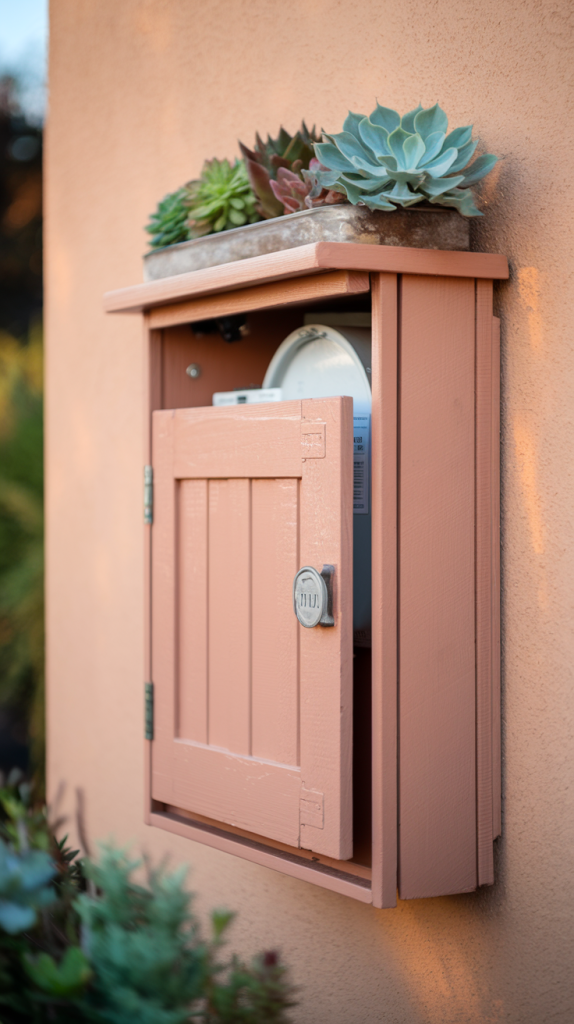
You can make your gas meter less noticeable by using a slim wall-mounted wooden utility box with a hinged front door. This keeps the meter easy to access but hidden from plain view. Choose a box just large enough to fit over the meter so it does not stick out awkwardly from the wall.
The top of the box can hold a narrow shelf strong enough for a few small potted succulents. Succulents are a good choice because they need little care and add natural texture to the space. Arrange the pots so water will not run onto the box or meter below.
Painting the box a soft terracotta color helps it blend in if your home has a desert-style stucco finish. This look is neat and fits many southwestern U.S. neighborhoods. Place the box at eye level for easy meter reading and plant tending.
When taking photos of this setup, use a DSLR or mirrorless camera with a 35mm or 50mm lens. Shoot in soft evening light at a slight angle to capture the wood grain and the different textures of the succulents. Aim for sharp, clear detail so you can see both the materials and the plants.
Utility Meter Cover Safety and Regulations
You must address both safety and legal rules when covering a utility meter. Covers should protect the meter and surrounding area but cannot block needed access or introduce fire risks.
Local Compliance Considerations
Most local regulations require that utility meters stay easy to reach for emergency crews and utility workers. You cannot build a cover that locks or permanently hides the meter.
Always check with your city or utility company before building. Some areas require permits or have size limits for covers. Rules can differ depending on if it is a gas, electric, or water meter.
Here’s a quick checklist:
- Meter must be visible for easy reading
- No locking doors or complicated latches
- Enough space for utility personnel to work
- Removable for emergencies
- Compliant with local and national fire codes
Ignoring these requirements might lead to fines or the cover being removed. Your local utility can tell you if there are any extra codes to follow for your specific meter or property.
Fire Prevention and Material Choices
The material you select for a meter cover affects safety. Using nonflammable or flame-retardant materials is recommended, especially near gas meters. Metal screens, bricks, and concrete often work well, while untreated wood and plastics can increase fire risk.
Gaps in the cover allow air to circulate, reducing heat buildup, which helps minimize fire danger. If you use wood, pick pressure-treated lumber and avoid placing the cover directly against the meter.
Avoid painting over glass or vents because these help with safety inspections and reading the meter. Make sure to secure all materials to help withstand weather and accidental bumps, but allow for quick removal if needed. Labeled covers can also help first responders find and access the meter fast.
Maintenance Tips for Utility Meter Covers
Taking care of your utility meter cover helps it last longer and protects your meter from damage. Routine maintenance can also prevent problems with reading or servicing the meter.
Cleaning and Weatherproofing
Keep your meter cover clean to stop dirt and debris from building up. Use a soft brush or cloth to remove dust, cobwebs, and leaves. For tough stains, use mild soap and water—avoid harsh chemicals, as these may damage certain materials like wood or plastic.
Check your cover for signs of weather damage such as cracks, rust, or warping. Replace damaged sections to keep the cover sturdy. If your cover is made of wood, inspect for rot and consider resealing or painting it with outdoor sealant every few years to protect against rain and sun.
Plastic and metal covers may need less frequent maintenance, but look out for fading or corrosion. Tighten loose fasteners and make sure no parts are sticking out that could cause injury. Good drainage around the base is important; make sure water isn’t pooling around the cover.
Access for Utility Companies
Utility companies need easy access to your meter for regular readings and maintenance. When installing or maintaining your cover, choose a design that can be removed quickly, such as a hinged or slatted screen. Never lock or block your meter cover unless your utility company says it is allowed.
Leave enough room around the meter for technicians to work safely. Here’s a simple checklist:
- Space at least 3 feet wide and 3 feet tall in front of the meter
- Removable panels or easy-to-open gates
- No items blocking the cover (such as plants or decorations)
- Clearly visible meter from the street or driveway
If you have questions about access, contact your utility provider before making any changes. Following these steps can help you avoid fines or extra service charges and ensures your meter cover stays compliant.


